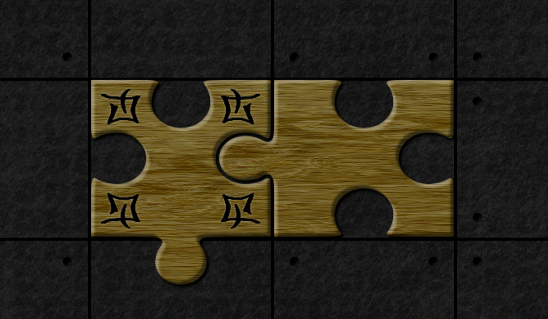Talisman Rune Bonuses
Talisman Runes
During the way to Spiritforge, we sometimes find talismans with markings on the corners:

There are five kind of runes in total: four are shown in the title icon of this guide, and the fifth one is shown above.
Placing the fragments inside the talisman in a certain manner will activate two very, very powerful hidden bonuses: one grants extra starting mana, and the other one grants extra mana at the start of each wave.
The First Bonus
The first bonus (extra starting mana) concerns the placement of rune fragments in each row.
If a row of talisman contains 3 or more runes of the same kind, the lights at the two ends of this row will lit, indicating that this row will generate a rune bonus “+x% initial mana”, where
x = 0.5 * (total rarity of fragments carrying the majority rune) * (1 or 1.2 or 1.4)
The final factor is determined by precisely how many fragments carry the majority rune: 1 if there are exactly 3 runes of the same kind, 1.2 if 4 of the same kind, and 1.4 if all fragments carry the same rune.
If multiple rows satisfies the rune condition, then the contribution is calculated for each row individually and then added together.
Example 1:

Although all of the fragments are carrying runes, there are no 3 runes of the same kind (only the 2nd and the 4th fragments share the same rune), and nothing happens.
Example 2:

This time we replaced the rightmost fragment so now we have 3 runes of the same kind (on 2nd, 4th and 5th fragment). The two end lights are now lit, indicating a bonus. The rarities of the fragments are 69, 49, 48, 29, 73, and the bonus is calculated as
0.5 * (49 + 29 + 73) = 75.5
and we will get a +76% (rounded) bonus of initial mana. Note how the calculation ignores the fragments that are not carrying the majority rune.
Example 3:

We replaced the center fragment so now we have 4 runes of the same kind (2nd to 5th fragment). Again the two end lights are lit. The rarities of the fragments are now 69, 49, 21, 29, 73, and the bonus is calculated as
0.5 * (49 + 21 + 29 + 73) * 1.2 = 103.2
and we will get a +103% (rounded) bonus of initial mana. Again the leftmost fragment does not participate in the calculation as it does not carry the same rune as others.
This bonus is applied to the initial mana after everything else:
mp = (300 + 7 * skill points + bonus from wizard levels) * (1 + x%)
which means a good combination of fragments in multiple rows can directly boost the initial mp two or three fold. Depending on the strategy, this can either save you some skill points or make your starting gem one grade higher, and is extremely helpful for low wizard levels (i.e. 50-100).
The Second Bonus
The second bonus (extra mana per wave) concerns the placement of rune fragments in each column.
If a column of talisman contains 3 or more runes of different kind, the lights at the two ends of this column will lit, indicating that this column will generate a rune bonus “+x mana at the start of each wave”, where
x = (total rarity of fragments carrying runes) * (1 or 1.2 or 1.4)
The final factor is determined by precisely how many kinds of runes there are: 1 if there are exactly 3 kinds of runes, 1.2 if 4 kinds, and 1.4 if all fragments carry completely different runes.
If multiple columns satisfies the rune condition, then the contribution is calculated for each column individually and then added together.
Example 1:

(Keep in mind that the picture is actually for a column; it is rotated by 90 degrees for reading convenience)
There are only 2 kinds of runes (one from the 1st fragment, and the other from the 3rd, 4th and 5th fragments), and nothing happens. (And no, “no runes” does not count toward a kind of rune.) This would have triggered a row bonus if placed in rows (that being said, we can not change which edge a edge fragment can go to).
Example 2:

This time we replaced some fragments so now we have 3 kinds of runes (1st and 3rd, 4th, 5th fragment). The two end lights are now lit, indicating a bonus. The rarities of the fragments are 45, 49, 23, 22, 24, and the bonus is calculated as
(45 + 23 + 22 + 24) * 1 = 114
and we will get a +114 bonus mana at the start of each wave. Note how the calculation ignores the fragments that are not carrying runes. Compared to rows, the columns are more efficient at including more fragments in the bonuses; the rows only calculate fragments with the same rune, while the column calculates all fragments with runes, even if they do not contribute to new kinds of runes.
Example 3:

We replaced more fragments so now we have all 5 kind of runes. Again the two end lights are lit. The rarities of the fragments are now 45, 80, 48, 22, 24, and the bonus is calculated as
(45 + 80 + 48 + 22 + 24) * 1.4 = 306.6
and we will get a +307 (rounded) bonus mana at the start of each wave.
This bonus is applied to each wave, and the bonus mana is given instantly; linked waves will instead give 2 waves worth of mana. This is in some sense even more powerful than the initial mana bonus. Consider a 50-wave battle with 200 mana bonus per wave. This is equivalent to 10k mana given gradually throughout the battle, and can be used to create a free grade 6 gem. For longer battles the bonus becomes even more powerful, and is extremely helpful even for mid wizard levels (i.e. 100-200)
